Editor: Nina
Scientists develop a multifunctional DNA origami-based nanovehicle for targeted co-delivery of doxorubicin and indocyanine green, enhancing the efficacy of imaging-guided chemo-phototherapy in breast cancer treatment.
Key Preview
Research Question
This study addresses the challenge of safely and efficiently delivering therapeutic agents to tumor cells in cancer treatment, specifically focusing on the synergistic effects of chemotherapy and photothermal therapy.
Research Design and Strategy
The research employs a novel approach using an AS1411-functionalized triangle DNA origami (TOA) to co-deliver doxorubicin (DOX) and indocyanine green (ICG) for targeted synergistic chemo-phototherapy.
Method
The study involved in vitro and in vivo experiments to evaluate the efficacy of the TOA in enhancing drug delivery, its release mechanisms, and overall therapeutic effects in breast cancer models.
Key Results
The TOA demonstrated over 90% tumor growth inhibition with minimal systemic toxicity, achieving a 2.5-fold targeted accumulation in tumor regions compared to controls.
Significance of the Research
This innovative multifunctional DNA origami-based nanosystem represents a promising strategy for enhancing targeted cancer therapy and offers a pathway for further advancements in biomedical applications.
Introduction
Cancer remains one of the leading causes of morbidity and mortality worldwide, characterized by uncontrolled cell growth and the potential to invade or spread to other parts of the body. Among various cancer types, breast cancer is particularly prevalent, affecting millions of women annually. Traditional treatment options for breast cancer often involve chemotherapy, which utilizes potent antineoplastic agents to inhibit cancer cell proliferation. One such agent is doxorubicin (DOX), known for its effectiveness against a variety of malignancies, including breast cancer.
In conventional cancer treatment, drug delivery typically relies on systemic administration, which aims to maximize therapeutic dosage while minimizing systemic toxicity. However, this approach presents significant challenges, including the non-selective distribution of chemotherapeutics, leading to collateral damage to healthy tissues. This often results in severe side effects such as cardiotoxicity, myelotoxicity, and a diminished quality of life for patients. Furthermore, the lack of targeted drug delivery can lead to suboptimal therapeutic outcomes, as the drugs may not reach the tumor site in sufficient concentrations to exert their intended effects.
The need for more effective and less harmful treatment strategies has propelled the development of innovative drug delivery systems. Recent advances in nanotechnology have introduced multifunctional carriers, such as DNA origami, which offer the potential for targeted delivery of therapeutic agents. This innovative approach allows for the encapsulation of drugs like DOX and imaging agents like indocyanine green (ICG) within a biocompatible nanosystem that can selectively target tumor cells. By utilizing targeting ligands, such as AS1411 aptamers that bind to nucleolin expressed on cancer cells, these systems aim to enhance drug accumulation at the tumor site while minimizing exposure to healthy tissues. This targeted delivery method addresses the critical challenges associated with traditional chemotherapy, offering a promising pathway for improved therapeutic efficacy and reduced side effects in breast cancer treatment.
Research Team and Aim
This study was conducted by a team of researchers from the University of Electronic Science and Technology of China, consisting of Mengyue Li, Geng Yang, Yue Zheng, Jiazhen Lv, Wanyi Zhou, Hanxi Zhang, Fengming You, Chunhui Wu, Hong Yang, and Yiyao Liu. The research was led by Dr. Hong Yang, who spearheaded the project throughout 2022. The research is titled “NIR/pH-triggered aptamer-functionalized DNA origami nanovehicle for imaging-guided chemo-phototherapy,” and it was published in the Journal of Nanobiotechnology.
The primary aim of the research, as articulated by Dr. Yang, was to develop a multifunctional DNA origami-based system capable of simultaneously delivering DOX and ICG, enhancing the efficacy of chemo-phototherapy while minimizing side effects. This innovative approach seeks to contribute to advancements in targeted cancer therapies by leveraging the unique properties of DNA nanostructures.
Experimental Process
Primary Technique
The primary technique utilized in this study is the fabrication of a multifunctional DNA origami-based nanovehicle (TOADI) for the targeted co-delivery of doxorubicin (DOX) and indocyanine green (ICG) in cancer therapy. This innovative approach leverages the unique properties of DNA origami to enhance drug delivery and imaging capabilities, aiming to improve the efficacy of chemo-phototherapy while minimizing side effects.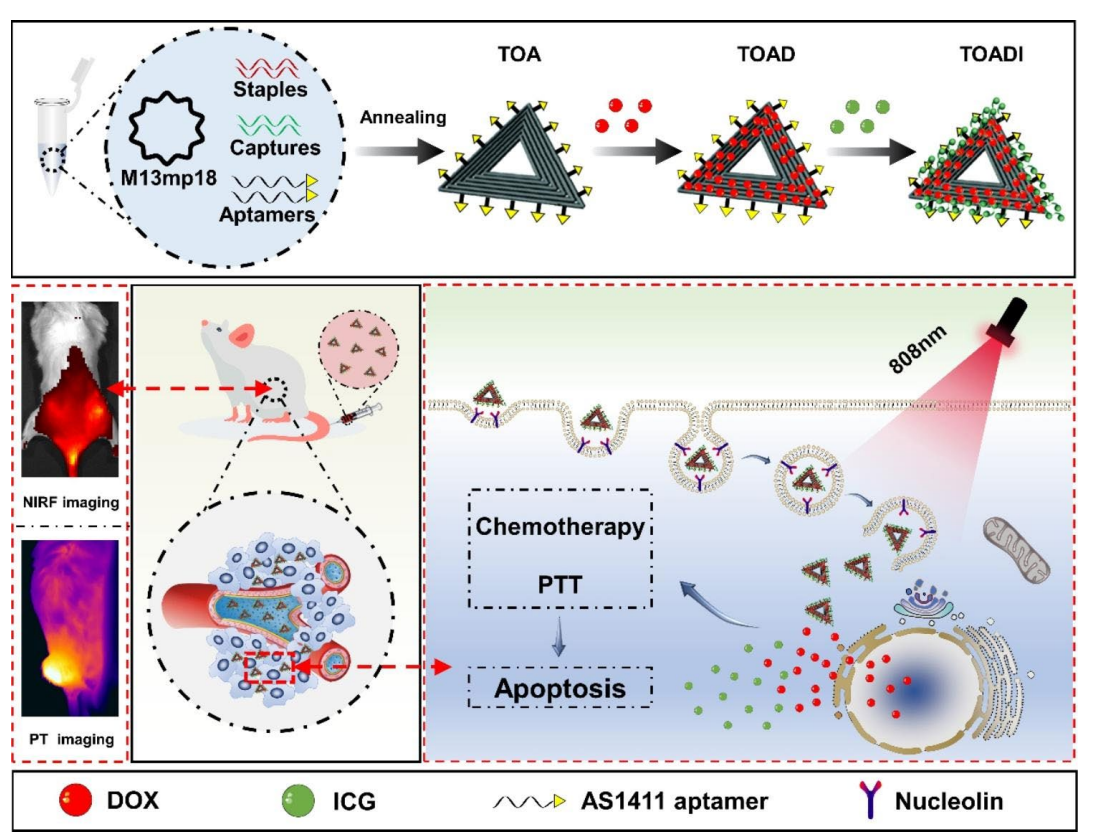
Scheme. 1 Schematic illustration showing the DNA origami-based nanoplatforms for synergistic cancer therapy involving PTT and chemotherapy against breast cancer in vitro and in vivo (TOA: Triangle DNA origami with AS1411; TOAD: Triangle DNA origami loaded with DOX; TOADI: Triangle DNA origami loaded with DOX and the ICG).
Experiment 1: Preparation of Triangle DNA Origami
Key Steps:
- Self-Assembly: Utilize the long single-stranded DNA scaffold (M13mp18) and a series of short staple strands in a molar ratio of 1:6 to assemble the triangle DNA origami (TO) through thermal annealing.
- Thermal Cycling: Subject the mixture to a thermocycler programmed to cool from 95°C to 25°C over 10 hours to facilitate proper folding of the DNA strands.
- Purification: Filter the assembled DNA origami using Amicon Ultra Centrifugal Filters (MWCO-100 K) to remove unbound strands and confirm the successful formation of TO.
Data Collection and Analysis:
- Characterization of the DNA origami was performed using Atomic Force Microscopy (AFM) and 1% agarose gel electrophoresis (AGE) to visualize the structure and confirm the successful assembly.
Results:
- The successful formation of triangle DNA origami was confirmed, with AFM images displaying distinct triangular structures and AGE showing slower migration of the functionalized DNA compared to the non-functionalized form, indicating the presence of the AS1411 aptamer.
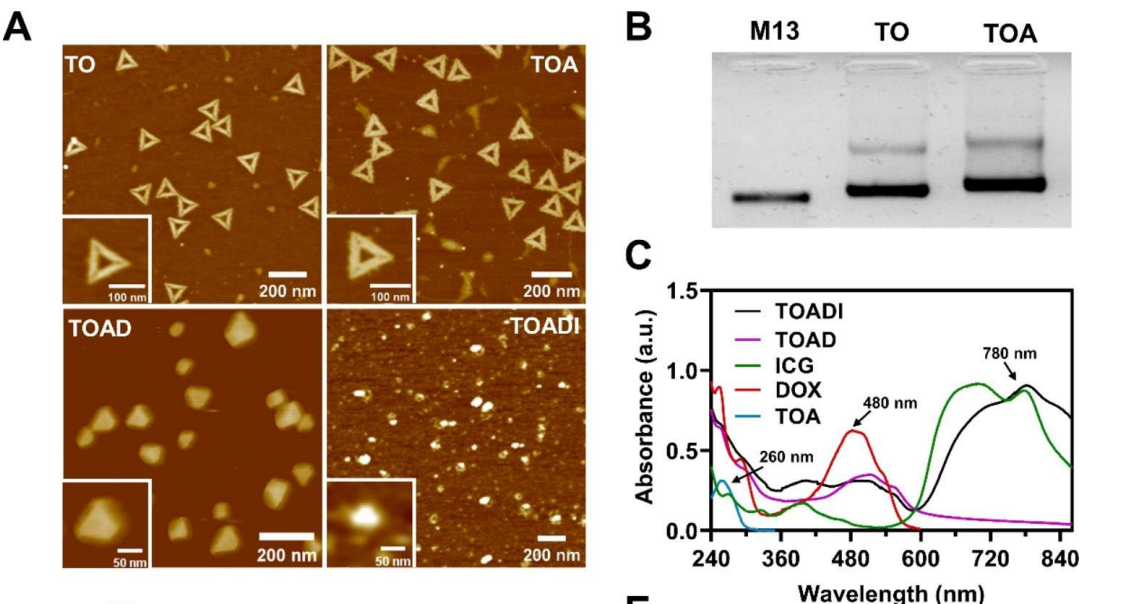
Figure. 1 Characterizations of DNA-based nanocarrier. (A) AFM characterization of the sequential constructs in the generation of the targeted DNA origami loaded with DOX and ICG (TOADI). Insets: enlarged images. (B) 1% agarose gel electrophoresis analysis of the self-assembled triangle DNA origami with AS1411; lanes 1-3: M13 scaffold, TO and TOA, respectively.
Novel Aspects:
- This study introduces a robust method for assembling DNA origami, highlighting the incorporation of AS1411 aptamers for targeted delivery, which enhances the selectivity and effectiveness of the treatment compared to traditional non-targeted delivery systems.
Experiment 2: Loading of DOX and ICG
Key Steps:
- DOX Loading: Incubate 20 nM of the triangle DNA origami (TOA) with 2 mM DOX for 12 hours to allow intercalation of DOX into the DNA structure.
- ICG Loading: Following DOX loading, incubate the DOX-loaded TOA (TOAD) with 1 mM ICG to allow electrostatic adsorption of ICG onto the positively charged DOAD.
Data Collection and Analysis:
- The loading efficiency of both DOX and ICG was assessed using UV-vis spectroscopy to measure absorbance peaks indicative of successful loading, alongside dynamic light scattering (DLS) to determine size changes before and after loading.
Results:
- DOX loading efficiency was over 50% after 12 hours, while ICG loading efficiency exceeded 70%. The size of the resulting nanovehicle (TOADI) decreased to approximately 72 nm, confirming successful drug encapsulation.
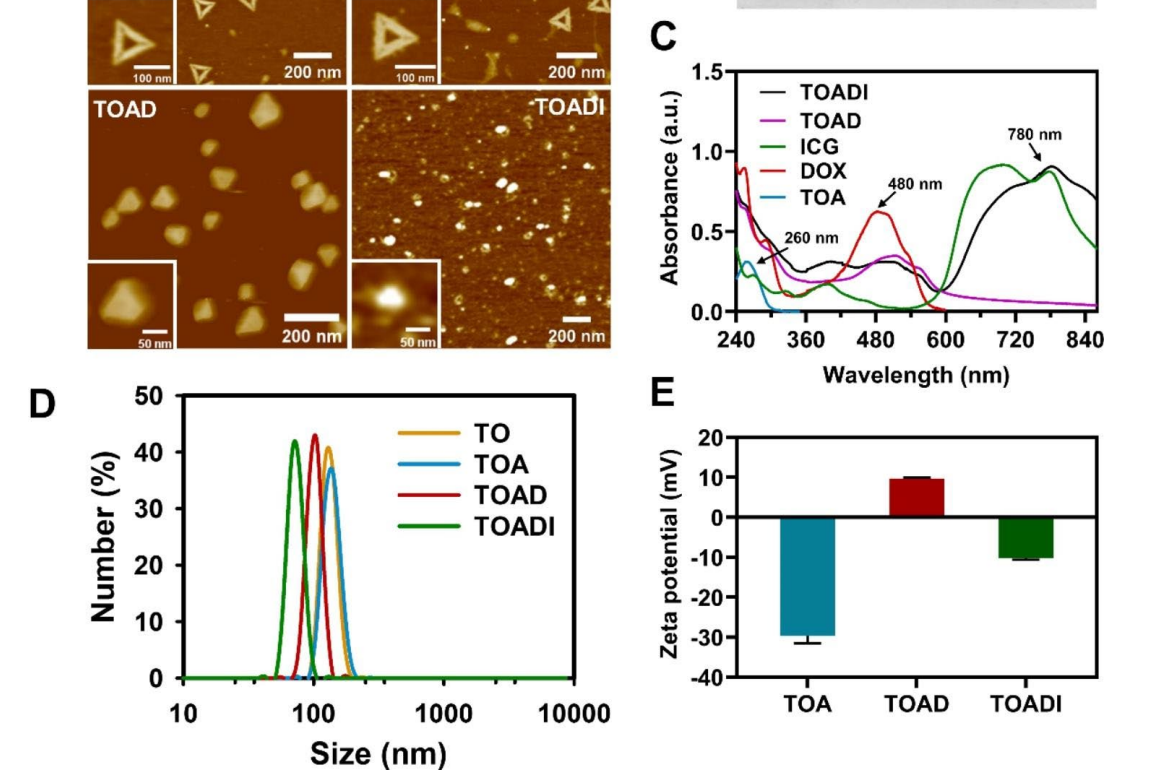
Figure.2 © UV-vis-NIR spectra of TOA, DOX, ICG, TOAD, and TOADI, respectively. (D) Dynamic light scattering of TO, TOA, TOAD, and TOADI.
Novel Aspects:
- This method of co-loading two therapeutics (DOX and ICG) into a single DNA origami platform represents a significant advancement in nano-delivery systems, enhancing the potential for synergistic therapeutic effects.
Experiment 3: Drug Release and Photothermal Effect Evaluation
Key Steps:
- Release Studies: Conduct in vitro drug release studies by incubating TOADI in buffers of pH 7.4 and pH 5.0, with and without NIR laser irradiation (808 nm, 1.0 W/cm²).
- Temperature Measurement: Monitor the temperature changes of TOADI under laser irradiation to evaluate its photothermal effect using an infrared thermal camera.
Data Collection and Analysis:
- The percentage of DOX released over time was quantified using fluorescence measurements, while temperature changes were recorded at set intervals to assess the photothermal response.
Results:
- DOX release was significantly higher at pH 5.0, with approximately 60% released under NIR laser irradiation within 24 hours, demonstrating the capacity for controlled release. The photothermal effects showed an increase in temperature of TOADI to 49.4°C after 5 minutes of irradiation.
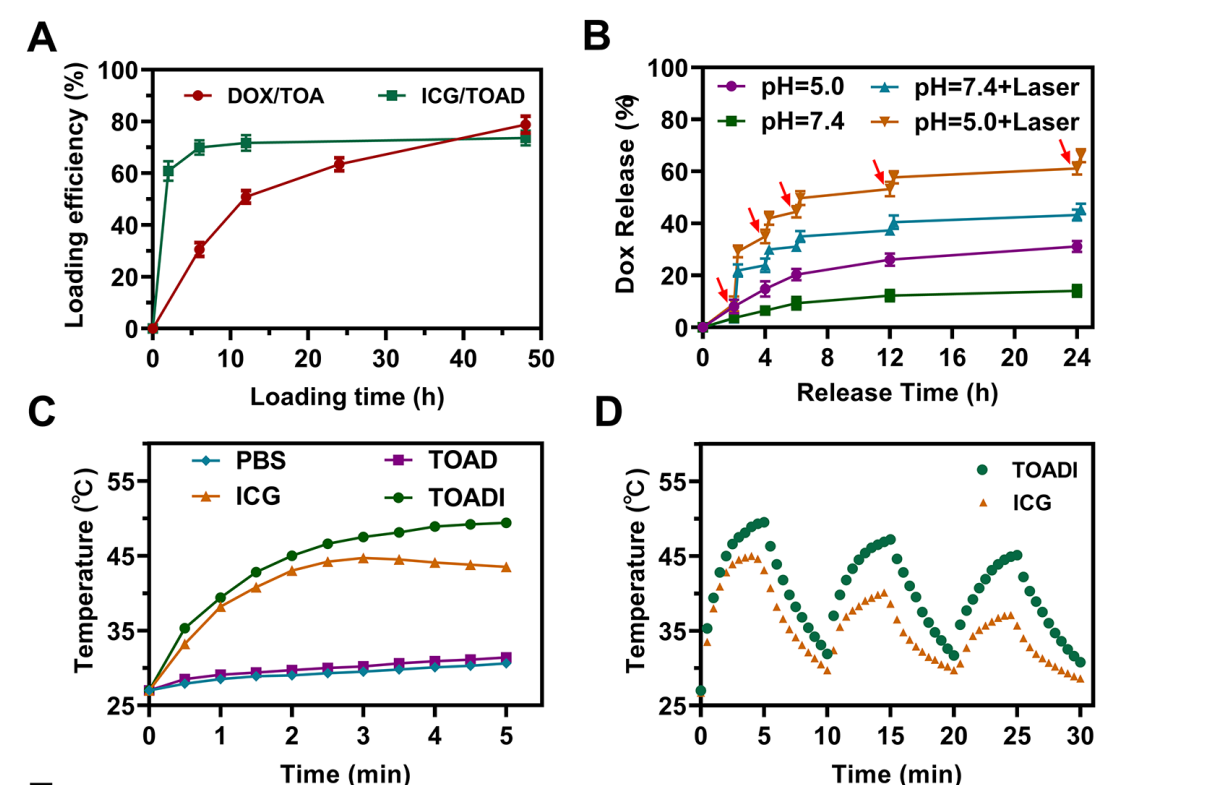
Figure. 3 (B)DOX release profiles of TOADI at different pH values in the presence of laser irradiation (808 nm, 1.0 W/cm2 , 5 min) at various time points. © The photothermal effect of TOADI (corresponding to DOX: 20 µM, ICG: 14 µM) under 808 nm irradiation (1.0 W/cm2 ), with ICG (14 µM), TOAD (corresponding to DOX: 20 µM) and PBS used as control samples
Novel Aspects:
- The ability to trigger drug release in response to acidic environments and laser stimulation presents a novel approach that offers greater control over therapeutic delivery compared to traditional passive release mechanisms.
Experiment 4: In Vitro Cellular Uptake and Cytotoxicity
Key Steps:
- Cell Culture: Incubate 4T1 breast cancer cells with TOADI and control formulations (TODA without AS1411) for 2, 4, and 6 hours.
- Flow Cytometry and Confocal Imaging: Assess cellular uptake using flow cytometry and confocal microscopy to visualize fluorescence from DOX and ICG.
Data Collection and Analysis:
- The mean fluorescence intensity (MFI) was quantified via flow cytometry to determine the uptake efficiency, while confocal images provided qualitative visualization of intracellular localization.
Results:
- TOADI demonstrated a threefold increase in cellular uptake compared to control formulations, with significant fluorescence observed in the nucleus post-laser irradiation, indicating effective delivery of DOX.
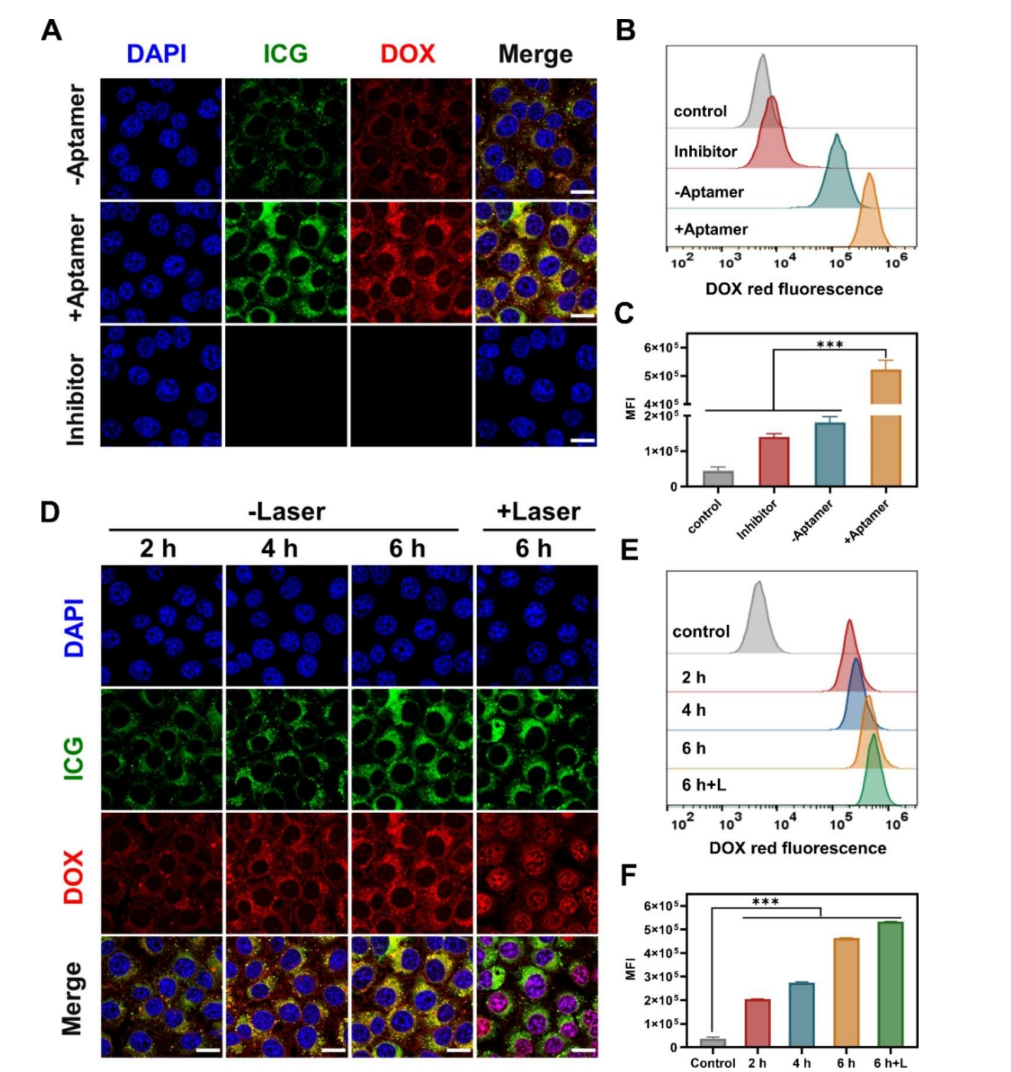
Figure. 4 In vitro cellular uptake triggered by the DNA nanostructure-based drugs codelivery system. (A) Confocal images and (B) flow cytometry analysis of 4T1 cells incubated for 6 h with three different conditions: DNA origami nanovehicle without AS1411, nanovehicle with AS1411, and nanovehicle with AS1411 as well as endocytosis inhibitor. © Mean fluorescence intensity (MFI) of 4T1 cells from flow cytometry analysis in (B). (D) Confocal fluorescence images and (E) flow cytometry analysis of 4T1 cells after incubation with TOADI for 2, 4, and 6 h without laser irradiation and 6 h with laser irradiation (808 nm, 1.0 W/cm2 , 5 min). (F) MFI of 4T1 cells from flow cytometry analysis in (E) (excitation wavelength: 480 nm for DOX, pseudocolor red; 780 nm for ICG, pseudocolor green; scale bar = 20 μm). The data are presented as the mean ± SD (n = 3). ***p < 0.001
Novel Aspects:
- This experiment showcases the enhanced targeting capabilities of AS1411-functionalized DNA origami, marking a significant improvement over non-targeted drug delivery methods in terms of specificity and efficacy.
Experiment 5: In Vivo Efficacy and Imaging
Key Steps:
- Animal Model: Establish a 4T1 tumor-bearing mouse model and randomly assign them to treatment groups, including TOADI and controls.
- Treatment Regimen: Administer treatments via tail vein injection and apply NIR laser irradiation for the TOADI group as specified.
Data Collection and Analysis:
- Tumor volumes were measured using calipers every two days, and fluorescence imaging was performed at various time points to evaluate biodistribution and tumor targeting.
Results:
- The TOADI + L group demonstrated a ~90% inhibition of tumor growth compared to controls, with enhanced accumulation in tumor regions confirmed through fluorescence imaging.
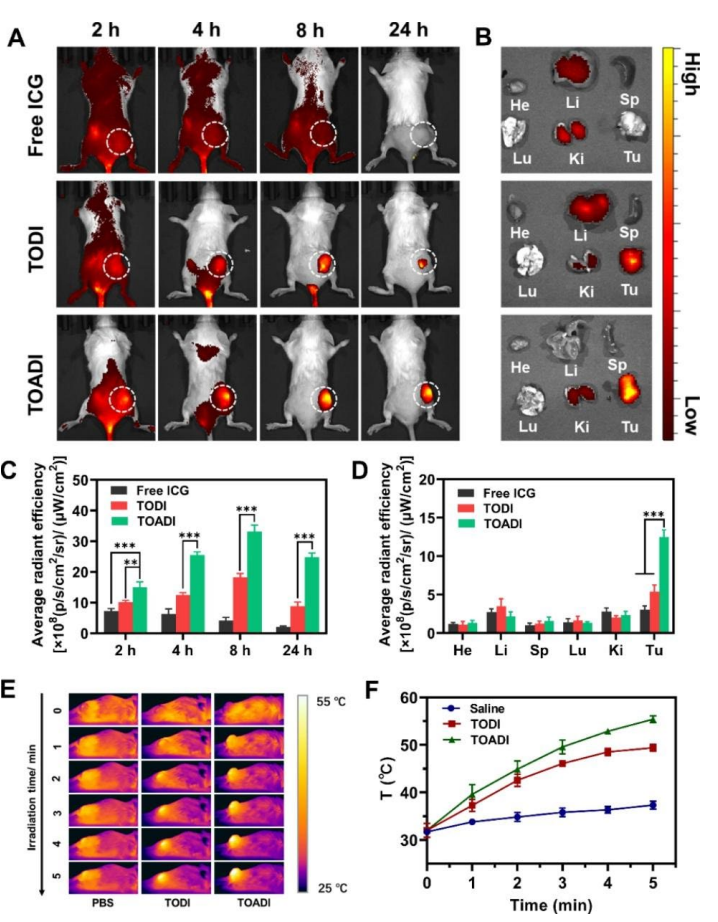
Figure. 5 In vivo biodistribution and photothermal imaging. ICG was served as an imaging agent to create in vivo fluorescence imaging.
Novel Aspects:
- The study’s in vivo findings underscore the potential of TOADI as a dual-function therapeutic and imaging agent, providing a significant advancement over existing delivery systems that typically lack both targeting and imaging capabilities.
Conclusion
The successful development of the multifunctional DNA origami-based nanovehicle (TOADI) for targeted co-delivery of doxorubicin (DOX) and indocyanine green (ICG) was achieved through a series of carefully designed experiments that demonstrated its potential in enhancing cancer therapy. By utilizing AS1411 aptamers for targeted delivery, the research team effectively improved the accumulation of the therapeutic agents at tumor sites while minimizing systemic toxicity.
The highlights of the study include the remarkable ability of TOADI to achieve over 90% inhibition of tumor growth in vivo, with a significant increase in drug accumulation at tumor regions compared to control formulations. Furthermore, TOADI exhibited outstanding photothermal effects and facilitated the controlled release of DOX in response to near-infrared (NIR) laser irradiation, demonstrating a synergistic effect that enhanced the cytotoxicity against breast cancer cells. Overall, this innovative drug delivery system represents a significant advancement in the field of cancer treatment, paving the way for future applications of DNA origami-based platforms in targeted therapy and imaging-guided approaches.
Reference:
Li, Mengyue, et al. “NIR/pH-triggered Aptamer-Functionalized DNA Origami Nanovehicle for Imaging-Guided Chemo-Phototherapy.” Journal of Nanobiotechnology, vol. 21, no. 186, 2023, https://doi.org/10.1186/s12951-023-01953-9.
